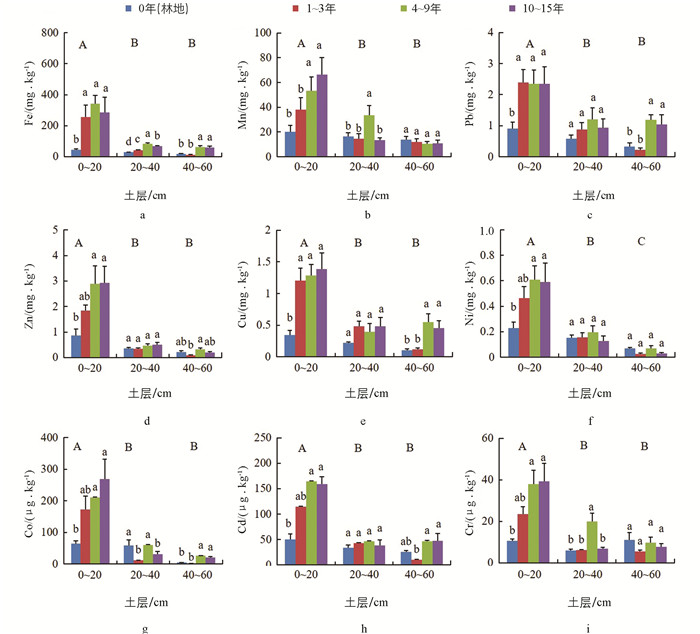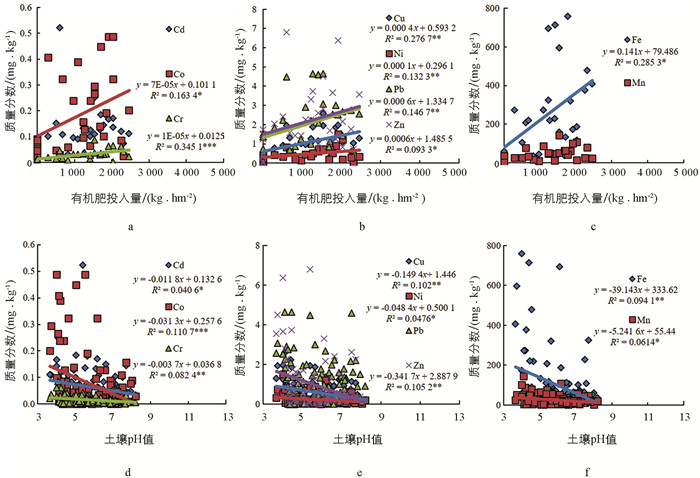-
开放科学(资源服务)标志码(OSID):

-
土壤健康正逐渐成为农业安全生产的焦点,维护土壤健康不仅是国家发展的重大需求,也是保证作物高产优质的关键. 但是,当前粗放的田间管理,如不平衡施肥等,严重威胁土壤生产力的提升[1]. 从全世界来看,重金属进入到土壤中的数量呈逐年增加趋势[2]. 柴冠群等[3]指出,重金属在土壤中呈现大量累积,且累积程度越高,蔬菜的重金属含量越高,食用后对人体造成的健康风险指数越高. 在集约化蔬菜生产系统中,土壤重金属累积明显,并通过增加可食用部分重金属含量潜在威胁人体健康[4]. 因此,进一步明确菜地土壤的重金属累积和迁移规律,对当前农业绿色发展至关重要,也与人体健康息息相关.
与其他作物相比,我国菜地土壤重金属累积速率较高,而菜地土壤重金属累积主要与种植时间、肥料的施用以及土壤酸碱性有关. Selles等[5]研究指出,施用肥料显著增加了土壤中的Cd全量以及有效态Cd的含量,进而增加了作物中Cd的含量. 李树辉[6]研究发现,土壤重金属的累积随着种植时间的增加显著增多,其中施用有机肥带入的重金属量远大于化肥. 因此施用有机肥会导致重金属的累积,并与施用时间成正比. 进一步的研究结果指出蔬菜生产系统的土壤酸化问题加大了土壤和蔬菜中Cd的累积[3]. 土壤的pH值对土壤中的许多化学反应以及化学反应过程都有很大的影响,比如对土壤中的沉淀溶解、氧化还原、吸附与解吸等起支配作用. 此外,大量研究均证明了土壤酸碱性对重金属在土壤中的迁移累积与赋存状态转变过程中起着关键的作用,比如土壤酸化可以活化土壤重金属进而导致重金属累积[7]. 西南地区是我国蔬菜生产的主要区域之一,在高温高湿的特殊条件下,有机肥施用对西南土壤重金属的累积及迁移的影响需要进一步研究,这将为区域内合理的有机肥施用提供支撑.
近年来,国内外对于不同土地利用类型、不同区域、不同施肥方法与施肥时间的土壤中重金属全量累积迁移的研究较多,但在农户尺度上对西南地区长期有机肥施用的不同种植时间和不同土层的土壤中有效态重金属的累积迁移规律的研究较少. 土壤元素有效量可被作物直接吸收利用,与土壤元素全量相比,能够更有效地反映植物营养元素的供给能力. 因此,本研究从有效态重金属的角度,以调研问卷及采集土样进行室内测定分析的形式,明确重庆市石柱县长期施用有机肥的菜地土壤中有机肥携带的重金属年平均投入量,分析不同种植时间与不同深度土壤中有效态重金属的累积迁移规律,以及土壤有效态重金属质量分数与有机肥年平均投入量和土壤pH值的相关性,为减缓菜地土壤重金属潜在的土壤污染提供理论依据.
全文HTML
-
研究区域位于重庆市石柱县(29°39′-30°32′N,107°59′-108°34′E),共有30个乡镇,该地区属于中亚热带湿润季风区,地表形态以中低山为主,兼有平原、丘陵(http://cqszx.gov.cn/). 根据中国气象数据网(http://data.cma.cn)的数据,石柱县2003年至2018年的年平均气温为15 ℃,年平均降雨量为1 352 mm. 该区域的主要土壤类型为黄壤土和紫色土,0~20 cm土层的pH值为5.29(水土比1∶2.5),可交换性钙和可交换性镁(1 mol/L NH4OAc提取)质量分数分别为279 mg/kg,31.3 mg/kg,土壤平均黏粒比例为20%~25%.
蔬菜是石柱县主要的种植作物之一,石柱县被称为“中国辣椒之乡”,辣椒和白菜是其蔬菜生产的主要种类,辣椒种植面积约2万hm2,每位农民平均0.2 hm2. 本研究以西南地区典型的辣椒-白菜轮作系统为研究对象,每年4月移栽辣椒(Capsicum annuum L.),8月收获,大白菜(Brassica campestris L.)在9月移栽,次年1月收获,随后菜地一直休耕至3月. 在辣椒、大白菜生长周期内,平均每年灌溉11次,施肥7次.
-
通过问卷调研的方式调查了重庆市石柱县71块菜地,主要包括辣椒、大白菜、番茄和黄瓜等蔬菜,调查数据包括菜地面积、菜地集约化生产的年限以及施肥种类和数量. 为保证一致性,在71块菜地中选取了24块仅轮作辣椒和大白菜的菜地作为研究对象,分布于石柱县大歇镇、六塘乡、三河镇和沙子镇等4个乡镇,每个村庄调研6位菜农,每位菜农对应一块菜地. 对每一块菜地的种植管理情况进行详细地记录,并确保每一块菜地的管理历史与调研时相似. 这24块菜地种植大白菜和辣椒的时间不同,但土壤类型一致. 除菜地之外,同时在每个村落附近选择与菜地相邻的2块林地作为对照(不施肥). 菜地的种植时间分为1~3年、4~9年及10~15年. 分别在每个村庄中随机选取各个种植时间段的2块菜地,加上对照,每个种植时间段共随机选取8块地.
调研数据显示,菜地施用的化肥主要有尿素、碳酸氢铵、磷酸二铵、复混肥和磷酸钙,当地菜农使用的有机肥主要有商品有机肥、牛粪、猪粪和鸡粪. 根据农户提供的各地块每年施入有机肥的种类与数量,按照不同有机肥重金属质量分数(表 1)[8-13]计算重金属的年平均投入量(重金属的年平均投入量=有机肥年平均施用量×有机肥中重金属质量分数)(表 2).
于2018年9月初,即在辣椒收获后,对24块菜地及邻近的林地采集土壤样品,用“S”形取样法,在每块地采集6个点,每个点分别采集0~20 cm,20~40 cm和40~60 cm 3个土层的土样. 在林地取土样时,去除腐殖层后再进行土样采集. 根据土壤耕作与作物根系分布的差异,选择这3个土层进行研究. 本研究区域的菜地,0~20 cm为耕作层,每年进行2次旋耕施肥的人工扰动;辣椒和大白菜的根最大生长深度小于40 cm,即作物根系会影响到20~40 cm土层的养分转化和吸收;40 cm以上的土层很难受到人类耕作或者根系生长的影响. 将每个深度的子样本混合均匀,得到每个地块不同土层的样本. 将采集的土壤样品风干,通过2 mm筛,风干土用二乙三胺乙酸(DTPA)浸提后,浸提液用电感耦合等离子体发射光谱仪对样品中9种元素进行测定[14].
-
本研究设计了新的计算方法即累积指数法来计算菜地土壤相对于林地土壤中有效态重金属的累积情况,用于表征菜地系统重金属累积的程度.
其中Li-n为种植年限n年的菜地土壤中有效态重金属i的累积指数;CHi-n指种植年限为n年的菜地土壤中有效态重金属i的质量分数,mg/kg;LHi-0表示种植年限为0年的林地土壤中有效态重金属i的质量分数,mg/kg.
-
用SPSS 20.0进行数据统计分析,并采用单因素方差分析法(ANOVA)进行统计学分析,当差异有统计学意义时(p<0.05),用邓肯多重比较来比较不同处理间的差异性. 利用Excel 2010软件对所有数据进行处理和图表制作.
1.1. 研究区域概况
1.2. 调研方式、样品采集与测定
1.3. 累积指数计算方法
1.4. 统计分析
-
本研究区域内农户施用的有机肥主要为鸡粪、商品有机肥,每块地平均施用量分别为1 509 kg/hm2,1 382 kg/hm2. 重金属年平均投入量由高至低依次为Fe,Mn,Zn,Cu,Cr,Pb,Ni,Co,Cd. 其中Fe的年平均投入量最高,在种植10~15年的菜地土壤中,Fe的年平均投入量最高达8 650 kg/hm2. Cd的年平均投入量最低,种植10~15年的菜地土壤中,Cd的年平均投入量为2.29 kg/hm2. 随着种植时间的增加,重金属年平均投入量呈递增的趋势. 其中,增加速率最快的为Co和Cr两种元素,与种植1~3年相比,种植4~9年和10~15年的菜地土壤中,Co的年平均投入量分别增加了3.34倍、3.30倍,Cr的年平均投入量分别增加了2.95倍、2.94倍(表 3).
-
研究区域内不同土层土壤中9种有效态重金属质量分数统计结果表明,在不同土层中,有效态重金属质量分数最高的是Fe和Mn,质量分数相对较少的是Cr和Co. 在表层(0~20 cm)土壤中,有效态重金属变异系数从大到小依次为Fe,Co,Cr,Zn,Mn,Cd,Ni,Pb,Cu,这9种重金属均属于高度变异(50%~100%),离散程度较大. 在20~40 cm土层中,有效态重金属变异系数从大到小依次为Co,Cr,Pb,Cu,Cd,Mn,Ni,Zn,Fe,其中Fe属于中度变异(15%~50%),而其余8种有效态重金属均属于高度变异. 在40~60 cm土层中,Co和Cu的变异程度最大,达到了极度变异(>100%),其余7种有效态重金属均属于高度变异. 在研究区域土壤中,有效态重金属累积程度从多到少依次为Fe,Mn,Pb,Zn,Cu,Ni,Co,Cd,Cr. 总体上来看,表层(0~20 cm)土壤中各有效态重金属质量分数显著高于下层(20~40 cm和40~60 cm)土壤(p<0.05). 各有效态重金属元素在表层土壤中的质量分数比在下层土壤中高120.91%~1 290.90%,其中有效态Cr和Zn两种元素的差别最大,表层土壤中有效态Cr,Zn质量分数分别是20~40 cm和40~60 cm土层的14倍和3倍、10倍和2倍(表 4).
总体而言,随着种植年限的增加,土壤中有效态重金属的累积显著增加. 在本研究区域的0~20 cm土壤中,种植0年的林地的有效态Fe,Pb,Cu累积量显著低于种植1~3年、4~9年、10~15年的菜地的累积量,种植4年以上的菜地土壤有效态Mn,Zn,Ni,Co,Cd,Cr的积累量显著增加(p<0.05). 在40~60 cm土壤中,随着种植年限的增加,有效态Fe,Pb,Zn,Cu,Co,Cd累积量呈现出显著增加趋势(p<0.05). 总体来看,与林地相比,菜地土壤中有效态Fe,Mn,Pb,Zn,Cu,Ni,Co,Cd,Cr质量分数分别增加了353%,67%,130%,67%,218%,68%,110%,105%,88%. 各重金属元素在0~20 cm土层中的有效态质量分数相对于40~60 cm土层中增加幅度最大(186.52%~1 291.59%),与40~60 cm相比,0~20 cm土层中增加幅度最大的元素是Co(1 291.59%),最小的为Pb(186.52%). 结果显示,各有效态重金属元素均有不同程度的迁移. Fe和Co两种元素均呈现出向20~40 cm,40~60 cm土层显著迁移的趋势(p<0.05). Mn和Cr向20~40 cm土层显著迁移,向40~60 cm土层显著迁移的元素有Pb,Zn,Cu,Cd(p<0.05)(图 1).
对研究区域内土壤中9种有效态重金属的累积指数进行计算并分析,结果发现,由于调研土的变异性,导致不同地点土壤测定的有效态重金属质量分数变异性较大,进而使个别累积指数呈现出较大波动. 其中,有效态Co,Cr,Cu,Fe,Mn,Ni在0~20 cm土层中累积指数高于20~40 cm土层,有效态累积指数在0~20 cm土层中高于40~60 cm土层中的有效态重金属元素有Cd,Cr,Fe,Mn,Ni,表明有效态重金属主要在表层(0~20 cm)土壤中大量累积. 在时间尺度上,有效态重金属累积指数整体上呈现出随着种植时间的增加而增加的趋势,其中种植时间对20~40 cm土层中有效态Cr,Fe的累积指数以及40~60 cm土层中有效态Cd,Cr,Fe的累积指数均有显著影响(表 5).
-
试验对本研究区域表层土壤(0~20 cm)中的有效态重金属质量分数与有机肥年平均投入量进行相关性分析(N=24). 结果可以看出,表层土壤中各有效态重金属质量分数随着农户有机肥年平均投入量的增加而增加. 在该研究区域内,表层土壤中有效态Cr的质量分数与农户有机肥年平均投入量存在极显著的线性正相关关系(p<0.001),有效态Co,Cu,Ni,Pb,Zn,Fe的质量分数随着有机肥年平均投入量的增加呈现出显著的增加(p<0.05),有效态Cd和Mn的质量分数随着有机肥年平均投入量的增加呈一定的增加趋势(图 2-a,b,c).
从本研究区域土壤中各有效态重金属质量分数与土壤pH值的相关性分析来看,土壤中各有效态重金属质量分数随着土壤pH值的升高而减少. 有效态Co的质量分数随土壤pH值的升高而极显著降低(p<0.001),有效态Cd,Cr,Cu,Ni,Pb,Zn,Fe,Mn的质量分数随着土壤pH值的升高显著减少(p<0.05),有效态Pb的质量分数与土壤pH值也呈负相关趋势(图 2-d,e,f).
2.1. 重金属年平均投入量
2.2. 重金属在土壤中的累积与迁移
2.3. 相关性分析
-
本研究中,农户施用商品有机肥以及鸡粪等有机肥的同时带入了重金属,且带入量随着种植时间的增加而增加. 研究发现,鸡粪、猪粪、牛粪等畜禽粪便以及商品有机肥中均含有重金属. 李发等[15]测定淮海地区120种鸡粪商品有机肥中Cu,Cd,Pb,Zn和As质量分数,发现Cd,As和Pb分别超标6.7%,47.05%和14.28%,商品有机肥的重金属超标问题仍然需要引起进一步关注. Wang等[16]研究指出猪粪中含有多种重金属,其中主要含Zn,Cu,Mn等元素. 贾武霞等[17]通过对我国部分城市的集约化养殖场畜禽粪便进行取样调查,发现重金属大量存在于猪粪、鸡粪、鸭粪和牛粪中,且Cu,Zn,As等存在超标现象. 在农业生产过程中有机肥的投入会将重金属带入到土壤中不断累积,进而增加作物对重金属的吸收,威胁人体健康. 吴荣等[18]研究发现添加有机肥显著增加了土壤重金属含量,同时小白菜、生菜和玉米等作物中重金属的累积量也显著提升,且与施用量和施用时间成正比.
试验结果可以看出,本研究区域内土壤有效态的Fe,Mn,Pb,Zn,Cu,Ni,Co,Cd,Cr等9种重金属出现不同程度的累积和迁移. 其中有效态Fe的累积量最高,这与Fe的年平均投入量最高相对应. 不同种植年限、不同土层中的有效态Fe质量分数(最小值:12.67 mg/kg)是中国土壤背景值(全量:2.94 mg/kg)的4.3倍,在种植1~15年的菜地表层(0~20 cm)土壤中有效态Cd的质量分数均超过了中国土壤背景值(全量:0.097 mg/kg)[19]. 赵小学等[20]对土壤重金属有效态含量与全量的关系进行研究,发现土壤重金属有效态含量与全量呈显著正相关,由此可见该研究区域土壤中Fe可能已经出现非常严重的累积,表层土壤中Cd也可能出现了较严重的累积. 李章平等[21]研究发现,重庆主城区土壤Cd,Cr,Cu,Ni,Pb,Zn的累积量分别为0.98,26.58,24.63,25.64,32.61,96.77 mg/kg,与此相比,本研究区域土壤中有效态Cd等6种重金属累积量均低于重庆主城区. 在本研究中,土壤Cd,Cr,Cu,Pb,Zn的有效态最高质量分数比中国农田土壤整体水平分别低31.49%,99.93%,95.21%,92.68%,96.61%[22]. 总体而言,菜地20~40 cm和40~60 cm土层中9种有效态重金属质量分数均高于林地(p<0.05),表明有效态重金属在研究区域地块中有向下迁移的现象,并且在表层土壤中存在明显的累积. 有效态重金属的累积还与地块的种植年限相关,种植年限长的地块土壤中有效态重金属的累积量显著高于种植年限短的地块,表明长期施用有机肥会造成土壤有效态重金属的累积. 王腾飞等[23]研究了长期施肥对土壤重金属累积和有效性的影响,得出施用有机肥提高了土壤重金属的有效性,并增加了重金属在土壤中的累积. 总体而言,表层土壤中9种有效态重金属含量的变化幅度较大,这可能与有机肥主要施用在表层土壤有关,表明该研究区域各地块表层土壤受人类活动的影响较大[24]. 由此可见,菜地长期的有机肥施用会增加土壤有效态重金属的累积量,主要体现在表层土壤中的累积,并存在逐渐向下层土壤迁移的趋势.
对有机肥年平均投入量、土壤pH值和有效态重金属质量分数进行相关性分析表明,有效态Co,Cr,Cu,Ni,Pb,Zn,Fe质量分数与有机肥年平均投入量呈显著正相关关系,即这7种重金属有效态质量分数随着有机肥年平均投入量的增加而显著增加. 除Pb外,其他8种重金属有效态质量分数与土壤的pH值均呈显著的负相关关系,即重金属有效态质量分数随土壤pH值的降低而显著增加. 而李随民等[25]研究发现土壤Cd含量随酸度的增加而减小,这是因为在酸性土壤中包括重金属在内的各阳离子容易淋失而导致Cd含量降低. 综上所述,本研究区域土壤重金属有效态累积的原因主要有两方面:一是有机肥投入时携带重金属进入土壤环境,从而增加了土壤中重金属的累积进而增加了有效态重金属向深层土壤迁移的风险;二是土壤pH值降低,即土壤酸化对重金属有活化作用,进而增加了土壤中有效态重金属的质量分数. 本文主要针对有机肥进行了分析,而菜地长期施用化肥,尤其是酸性氮肥会导致土壤严重酸化,这也是土壤有效态重金属质量分数增加的另一原因. 因此,在农业生产过程中,需选择重金属质量分数达标的肥料,控制施用量,以防重金属的带入,减少肥料的过量施用,有效防止土壤的酸化.
在农业生产过程中,可以通过优化管理方法来降低重金属在农田中的累积与污染. 首先,从重金属来源进行阻控,根据作物养分需求与土壤重金属最大环境容量,在保证作物产量的前提下,严格控制化肥与有机肥施用量,以及利用重金属去除技术对有机肥进行无害化处理. 李树辉[6]研究指出,减少化肥和有机肥用量显著降低了重金属在土壤中的累积迁移;杨鹏[26]研究中对有机肥进行去除重金属的无害化处理后,显著降低了Zn,Cu,Ni等重金属在土壤以及玉米中的累积量. 其次,可以对酸性土壤进行改良,钝化土壤重金属,从而降低土壤重金属污染. Ownby等[27]研究发现加入改良剂可明显降低Pb,Zn的生物有效性. 对于蔬菜种类和品种而言,农业上可以选择种植对重金属吸收能力弱的作物类型与品种,或培育对重金属耐性高的品种. 刘建国[28]研究得出不同糙米品种对Cd的吸收不同,Li等[29]通过试验得出了甘蓝型油菜的几种HMA基因(BnHAM2;2,BnHAM2;3,BnHAM2;5)在Cd胁迫下有响应,验证得出BnHMA2;3可能在甘蓝型油菜叶片Cd转运中起重要作用. 在农业生产中,对于日益严峻的土壤重金属污染,需要根据不同的作物类型、土壤环境、气候条件、污染程度等[30]选择合理的治理方法. 在农业生产中优化管理措施,最大化降低土壤的重金属污染风险,保障作物安全生产.
-
1) 本文通过对重庆市石柱县农户菜地有机肥管理调查,发现农户主要施用的有机肥种类为商品有机肥和鸡粪. 有机肥带入的重金属中Fe的年平均投入量最高,Cd的年平均投入量最低. 随着种植时间的增加,重金属年平均投入量呈现递增的趋势.
2) 对研究区域内土壤中9种有效态重金属质量分数进行测定分析,得出重庆市石柱县菜地不同土层土壤中有效态重金属质量分数从大到小依次为Fe,Mn,Pb,Zn,Cu,Ni,Co,Cd,Cr. 土壤有效态重金属的累积与种植年限有关,种植年限越长,累积量与累积指数显著增高;表层土壤(0~20 cm)有效态重金属累积程度最高.
3) 研究区域内不同地块表层土壤的有效态Fe,Mn,Cu,Ni,Pb,Zn,Co,Cr的质量分数与有机肥年平均投入量呈显著正相关关系,不同地块不同土层有效态Fe,Mn,Cu,Ni,Zn,Cd、Co,Cr的质量分数与土壤pH值呈显著负相关关系,说明有机肥的投入和土壤的酸化显著增加了土壤有效态重金属的质量分数.




 下载:
下载:
